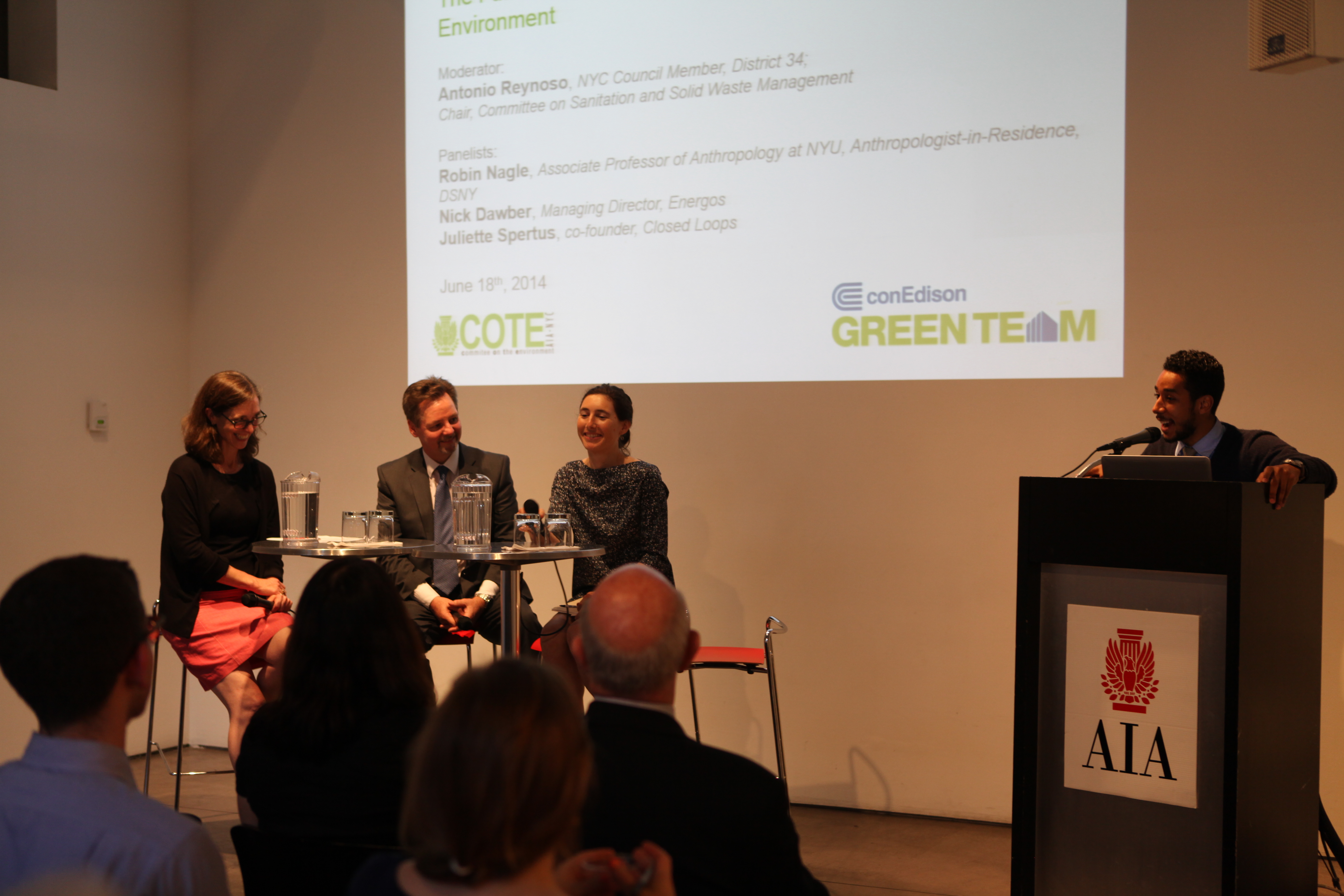by: Claire Webb
The Center for Architecture hosted an event that tackled an un-sexy but pressing issue in NYC: garbage. As the host Antonio Reynoso, a NYC council member, said, dealing with garbage is “not too glamorous and you’re not going to cut the ribbon.” The councilman made light of an issue that’s often forced into the dark, joking with the audience that he was “gonna talk trash with you – because that’s what we do in Brooklyn.” Over-concentration of garbage and a high rate of asthma and traffic in his district spurred him to take the position of chair of the NYC Committee on Sanitation and Solid Waste Management. “Sanitation,” he said, “is our first line of defense in making sure our environment is more sustainable.”
Robin Nagle, associate professor of Anthropology at NYU, and anthropologist-in-residence at the NYC Department of Sanitation (DSNY), briefed the audience on the fascinating history of garbage in the city. Peter Stuyvesant implemented landfilling that actually grew the city in the 1600s, expanding the physical territory of Manhattan. But as dealing with the waste became arduous (not to mention smelly and hazardous), the city turned to incinerating it on Governors Island. That energy “lit the Williamsburg Bridge,” lending a “kind of grandeur, a kind of grace” to dealing with waste. She cited the infamous Fresh Kills “park” on Staten Island; they couldn’t even “call it a landfill” because of the negative connotations. Its recent reappropriation, though, is the “most ambitious Parks Department project yet…[It’s] a deep travesty turned into an environmental accomplishment.” She ended on a hopeful note, saying that areas that convert garbage could be the “cathedrals of our neighborhoods.”
Nick Dawber, managing director at the waste-to-energy technology company Energos, highlighted the challenges that Glasgow faces, offering an informed comparison to NYC. In Glasgow’s transition from a shipbuilding city into to a modern hub, it has had to pivot from its dirtier, industrial past: the city is filled with densely populated tenement houses (not unlike an earlier Manhattan). To meet Scotland’s bold goal to recycle 75% of waste, Energos has contracted with a private company to gasify remaining waste after recycling it to fuel.
Finally, Juliette Spertus, co-founder of the planning and development firm Closed Loops, illuminated the onerous burden that garbage imposes, even if it’s seemingly invisible to a city’s denizens. Trucks transporting Manhattan’s waste, for example, go as ludicrously far as South Carolina. So, she asked, how do we change this? There are feasible ways, Spertus asserted: Why not strap a tube to the High Line? To the 2nd Avenue subway construction? Connect tubes to NYCHA buildings? That way, garbage could be collected in small batches, creating an “urban network of waste” that would be more fluid and agile. This system would also eliminate smelly, dangerous trucks. The material would be funneled and then processed on a small scale at an anaerobic digester to produce gas and electricity, helping to “close the loop” instead of polluting linearly. Our system now, she said, “is not at all designed.” The new tubes need not be tucked away, but rather, could be animated, didactic, and a cultural experience. The processing terminal could have windows “so we could all appreciate the process.”
Spertus also proposed measuring our waste and then broadcasting those numbers, just as we already do for gas, electricity, and water. When NYC started metering water, she noted, the city saw a 16% savings. Even in extreme temperatures, we’re careful with AC and heating so as to not gouge our pockets. Why should waste management be any different? “We need a pilot program,” she said, “for people to see and appreciate garbage.” While that project might sound unappetizing, recent efforts to educate the public about conservation (for water, wetlands, etc.) have proven effective; why not garbage education? It’s clear that the panelists see dragging waste management out of the dark ages, and into the public’s awareness – and even nudging us to appreciate it – is a looming first step for finding constructive ways to deal with this issue.
Editor’s Note: If you missed “GETTING WASTED,” a recording of the program is available for viewing on the Center for Architecture’s Vimeo page, here.
Claire Webb studied astronomy and philosophy at Vassar College, but an interest in art history and architecture led her to the position of Marketing Director at Edelman Sultan Knox Wood / Architects.
Event: GETTING WASTED: The Future of NYC Garbage and Its Impact on Our Environment
Location: Center for Architecture, 06.18.14
Speakers: Robin Nagle, Associate Professor of Anthropology, NYU, and Anthropologist-in-Residence, NYC Department of Sanitation; Juliette Spertus, Co-founder, Closed Loops; Nick Dawber, Managing Director, Energos; and Antonio Reynoso, NYC Council Member, District 34, and Chair, NYC Committee on Sanitation and Solid Waste Management
Organizers: AIANY Committee on the Environment
Sponsors: ConEdison Green Team








